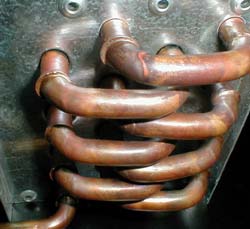|
|
|
|
 Radiator Roundup 1 Radiator Roundup 1
|
|
Date Posted: Aug 15 2001
|
|
Author: Joe
|
|
|
|
|
Posting Type: Review
|
|
Category: H2O and High End Cooling Reviews
|
|
Page: 1 of 3
|
|
Article Rank:No Rank Yet
Must Log In to Rank This Article
|
|
|
|
|
Note: This is a legacy article, imported from old code. Due to this some items on the page may not function as expected. Links, Colors, and some images may not be set correctly.
|
|
|
Radiator Roundup 1 By: Joe
|
|
|
|
Welcome to ProCooling.com's first, and much anticipated, Radiator Roundup.
This project has been in the works for many months along with the WaterBlock Roundup and is finally a reality. This roundup is comprised of almost 57,000 Temp readings, from over 12 thermal/flow sensors Including coolant temps, air temps, coolant flow, and cold plate. The goal in this roundup was not to sell you on anything, or try to make one product look more attractive in any way, but to show you where each of the products do better or worse in any certain area.
With that said, lets get on with it and see who the contenders are today.
|
|
|
|
|
|
|
|
|
|
|
BeCool "AquaCoil"
|
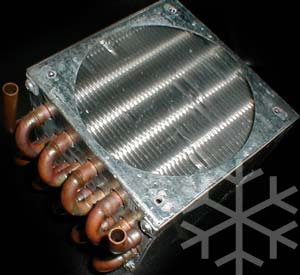 |
|
|
The AquaCoil is a similar radiator to the condenser units in air conditioners and tranny coolers. Its Copper tubing and Aluminum fins are a norm for this
kind of radiator.
BeCool released this radiator a few months after Danger Den released their "Cube" radiator. Both of these radiators share the same basic design and function. The AquaCoil is a bit bigger and has more surface area than the Danger Den Cube.
|
|
|
 |
|
|
|
|
|
The Flow pattern weaves back and forth through the radiator in a normal progressive fashion
With these kind of radiators the orientation is everything for getting all the air out of the lines. Because of how it is designed, if you fill the
radiator from the top and have the "exhaust" coming from the bottom, you will trap mass amounts of air in the radiator. Air in a radiator is a nasty thing as it will not only aid in corrosion, but also lower the coolants
contact with the copper tube in areas.
|
|
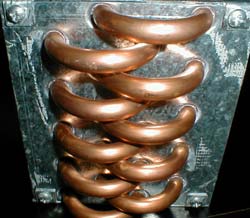 |
|
|
|
|
|
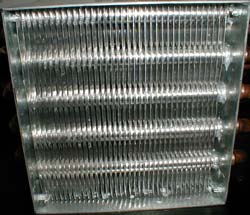 |
|
There is a lip on the front and back of the radiator extending out from the fin surface. This serves 2 functions. 1. it will help stop stuff from
hitting the fins and bending them. 2. it will allow the Fan to stand off the face of the radiator easily giving better air flow through the radiator. Its mounting holes on the front for 120mm fans is a very helpful
feature. This is one of the easiest radiators to mount your fan and go. This is all 3/8" Copper tubing with some rather tight turns lowering the overall coolant flow through it.
|
|
|
|
|
BeCool has released an upgraded version of this radiator, but did not respond to a request to get one to test in place of this radiator.
|
|
|
|
|
|
|
|
|
|
Danger Den "Cube"
|
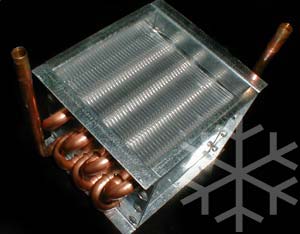 |
|
The guys over at Danger Den were the first to the scene with the "cube" style radiator. The radiator is quite a bit smaller in over all size than the
AquaCoil and also in the fin surface area it offers.
This radiator uses the same type of Copper tube/Aluminum fin configuration the AquaCoil does.
|
|
|
|
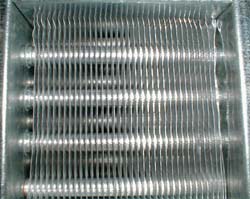 |
|
|
|
|
|
Looking at the front of the radiator you can see there is a good deal of open space for mounting a fan and giving it a nice stand off distance from the fins.
On the back its a whole nother story though. The fins are flush with the
galvanized case. Mounting a fan to the DD Cube can be interesting, if not just down right hard. In the testing, lots of duct tape was used :)
|
|
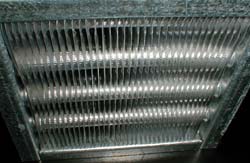 |
|
|
|
|
|
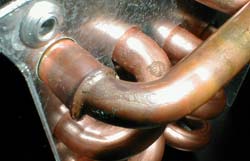 |
|
|
|
|
Another one of the Achilles heals of the DD Cube is its highly constrictive bends. All Cu lines are 3/8", except at the turns.
In some areas the Cube's copper tubing constricts to around 1/4". Having a un restricted flow through a radiator is very important due to how a radiator cools the coolant. If you have a kink in the line it will increase the velocity of the coolant and pressure in order to get the same amount of coolant through an area. Coolant that's moving faster with less volume will not be cooled as well as a coolant with less velocity and more volume. We will talk more about this later on in the review.
|
|
|
|
|
|
|
|
|
|
|
|
|
|
|
HWLabs "Black Ice"
|
|
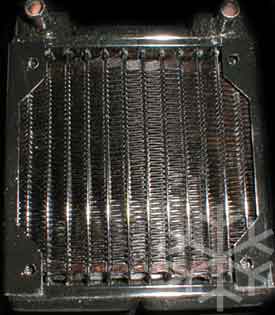 |
|
|
This radiator, while it looks pretty uneventful, is the first radiator designed from the ground up to be used on a PC. HWLabs designed it as small as
possible, yet easy to mount fans to. One other thing that sets this radiator apart from the others, is that its tubes and fins are made completely of copper. It is the smallest radiator in the roundup for total
size.
|
|
|
|
 |
|
|
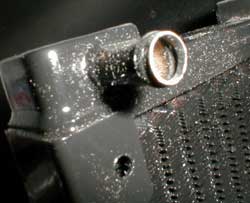 |
|
|
|
The flow path through this radiator uses parallel runs through the fin surface in order to maximize the coolants surface contact, and while lowering overall
flow restrictions. The flow goes from one of the fittings down the first 3 tubes, then weaves up and down every 3rd set of tubes.
The tubes are the small ellipse shape lines that run from the bottom to the top of the radiator at all of the zig zag fins connect to.
These are not the standard type of round copper tubes like the other radiators used. This design is adopted from high end oil coolers, and heatercores. For being half the size of some of the other radiators it will be interesting to see how it performs.
The radiator offers easy mounting for 2 120mm fans ( one on each side) and is well shrouded to force the air through the fin surface area.
|
|
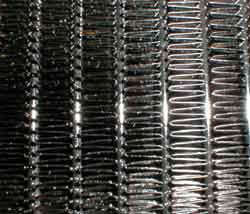 |
|
|
|
|
|
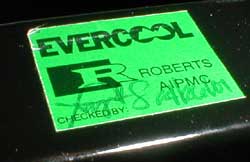 |
|
|
|
|
Something that I found interesting was a signed "Checked by" sticker.
This was not a stamp, someone hand signed it. It's rare today to get something that actually had human contact. Especially when you talk about Q/A since there is a severe lack of that these days.
|
|
|
|
|
|
|
|
|
|
|
Overclock-Watercool "Big Momma"
|
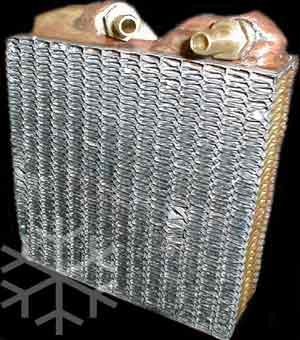 |
|
|
This is Overclock-Watercool's big bad boy ( or momma). This is essentially a heatercore.
But its a very high quality one in both design and materials. In total surface area this thing dominates the entire pack of radiators in this test. It also has more flow than any other radiator in here.
Its made primarily of copper and brass, and is then edge sealed with lead solder. That also makes this the heaviest of them all. ( the AquaCoil is very
close to the same weight).
|
|
|
|
 |
|
|
|
The "tubes" on this radiator are much like the Black Ice radiator.
These thin brass "fins" are the tubes. There are 7 tubes running from the top to the bottom on each side. This offers some extreme surface contact for the coolant, and also slows the coolants velocity very much, allowing it to cool before going back to the core. The rule of thumb is - move the coolant as fast as you can to the waterblock ( you will hit a limit of how much cooling will happen, but you will not drop in cooling performance past that point), and run it as slow as you can through the radiator ( this allows the most heat to dissipate to the air).
Mounting fans to the Big Momma can be a chore.
Since there is clearly no holes made for mounting a fan I have used Zip ties and chunks of silicone hose to stand the fan off from the face of the radiator. The radiator is about 160mm big so a 120mm fan without a baffle and being stood off the face will only be using a fraction of the radiators ability to cool.
The radiator comes with 3/8" or 1/2" fittings which are soldered in. This is a 3/8" model.
|
|
|
|
|
That's who's in this roundup. These are some of
the most common and most widely used radiators around, so I felt it was appropriate to run the first roundup with this group. Now lets look at the testing setup and what we used to stress the radiators.
|
|
|
The Testing Rig/Setup
 |
|
|
|
| Random Forum Pic |
 |
| From Thread: block designs |
|
| | ProCooling Poll: |
| So why the hell not? |
|
I agree!
|
 67% 67%
|
|
What?
|
 17% 17%
|
|
Hell NO!
|
 0% 0%
|
|
Worst Poll Ever.
|
 17% 17%
|
Total Votes:18Please Login to Vote!
|
|






 Radiator Roundup 1
Radiator Roundup 1









